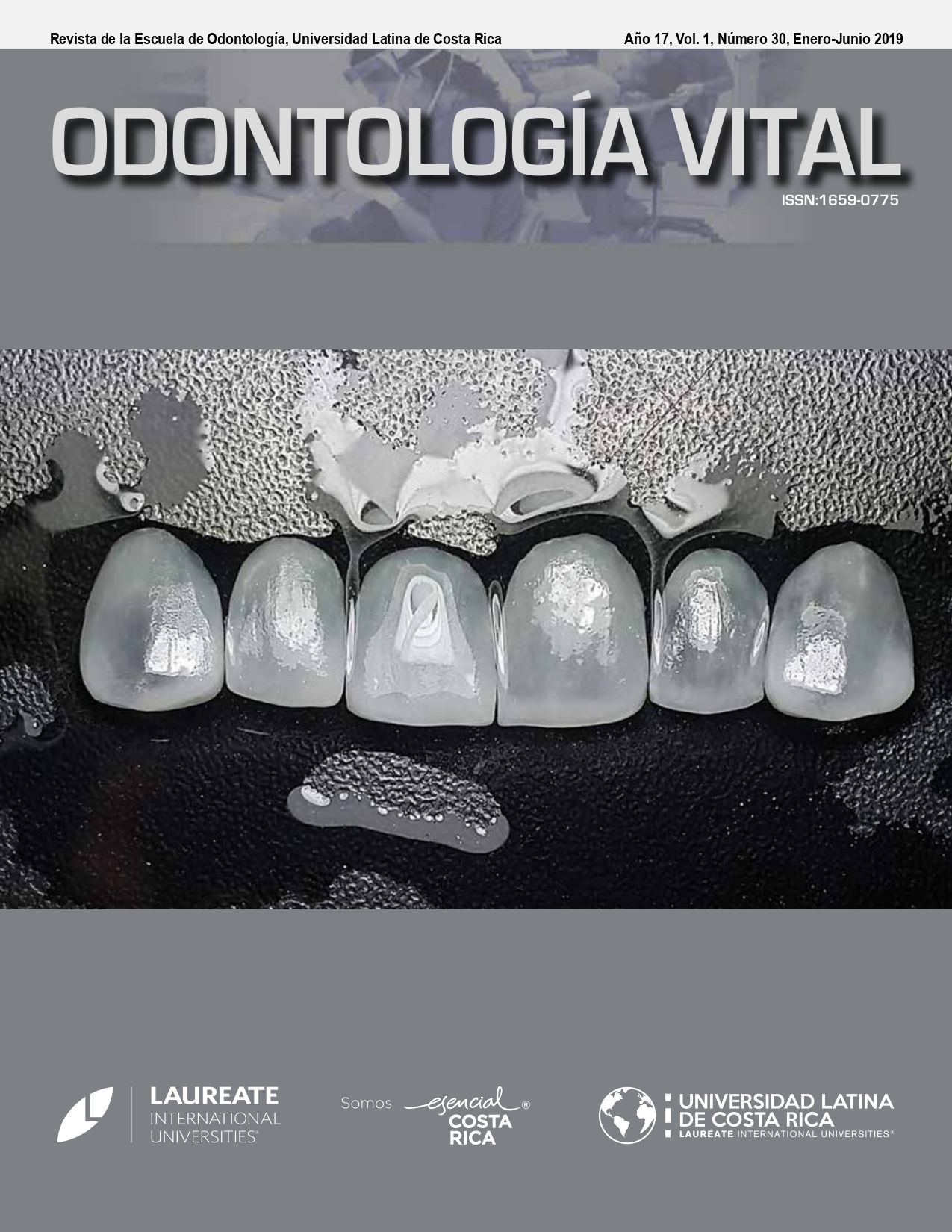Front sector rehabilitation with porcelain contact lens venners guided by digital planning. Case report
DOI:
https://doi.org/10.59334/ROV.v1i30.141Keywords:
digital smile design, Veneers, contact lensAbstract
Patients increasingly come to the dental office to improve the appearance of their smile, expanding the demand for aesthetic procedures, and it is the dentist´s responsibility to offer different techniques for the patient to receive an optimal treatment, aimed at preserving the dental tissues in this aspect, unprepared ceramic veneers, or contact lenses, are a conservative alternative, which improves the aesthetics of the front sector, the following case describes a minimally invasive aesthetic restorative alternative for the rehabilitation of the anterior sector, with the use of IPS e. max® Press porcelain, highlighting the planning process through digital design in two dimensions.
Downloads
References
Aha, Q., Qamheya, M., & Arisan, V. (2016). Lithium disilicate restorations: Overview and a case report. Journal of Dentistry & Oral Disorders, 2(9), 2–5.
Brando, A., Anchelia, S., & Quea, E. (2015). Resistencia a la compresión de carillas cerámicas de disilicato de litio cementadas con cemento resinoso dual y cemento resinoso dual autoadhesivo en premolares maxilares. Int. J. Odontostomat., 9(1), 85–89. https://doi.org/10.4067/S0718-381X2015000100013
Cedeño Salazar, R. (2016). Estabilidad del color de las cerámicas de disilicato de litio. TDX (Tesis Doctorals En Xarxa). Retrieved from http://www.tdx.cat/handle/10803/374247
Cedillo Valencia, J. (2012). Carillas prefabricadas en una sola visita. Adm, LXIX(6), 291–299.
Chu, S., & Ahmad, I. (2005). A historical perspective of synthetic ceramic and traditional feldspathic porcelain. Practical Procedures & Aesthetic Dentistry, 17(9), 593–8.
Coachman, C., Calamita, M., & Schayder, A. (2012). Digital smile design : uma ferramenta para planejamento e comunicação em odontologia estética. Dicas, 1(2), 36–41.
Coachman, C., Gurel, G., Calamita, M., Morimoto, S., Paolucci, B., & Sesma, N. (2014). The influence of tooth color on preparation design for laminate veneers from a minimally invasive perspective: Case report. International Journal of Periodontics & Restorative Dentistry, 34(4), 453–459. https://doi.org/10.11607/prd.1900
De Jesús, J., & Valencia, C. (2011). Carillas de porcelana sin preparación. Revista Adm, 68(66), 314–22314. Retrieved from http://www.medigraphic.com/pdfs/adm/od-2011/od116k.pdf
Dientes, P., & Históricos, A. (2012). MollinedoPatzi Marcela Andrea 1.
Etman, M. K., & Woolford, M. J. (2010). Three-year clinical evaluation of two ceramic crown systems: A preliminary study. Journal of Prosthetic Dentistry, 103(2), 80–90. https://doi.org/10.1016/S0022-3913(10)60010-8
Fondriest, J., & Roberts, M. (2010). Minimal preparation veneer case selection process. Inside Dentistry, 6(March), 36–43.
Frencken, J. E. F. M. (2013). De historie en wetenschappelijke ontwikkeling van de atraumatic restorative treatment. Nederlands Tijdschrift Voor Tandheelkunde, 120(12), 677–681. https://doi.org/10.5177/ntvt.2013.12.13123
Grohmann, P., Bindl, A., Hammerle, C., Mehl, A., & Sailer, I. (2015). Three-unit posterior zirconia-ceramic fixed dental prostheses (FDPs) veneered with layered and milled (CAD-on) veneering ceramics: 1-year follow-up of a randomized controlled clinical trial. Quintessence Int, 46(10), 871–880. https://doi.org/10.3290/j.qi.a34701
Lima, A. P., Paranhos, L. R., & Rode, S. de M. (2017). Facial pattern and typology influencing smile aesthetic pleasantness. Journal of Oral Research, 6(7), 170–171. https://doi.org/10.17126/joralres.2017.049
Lovadino, J. R., Sano, R., Terada, S., & Pascotto, R. C. (2012). Advances in dental veneers : materials , applications , and techniques, 9–16.
Obradovic-Djuricic, K., Medic, V., Dodic, S., Djurisic, S., Jokic, B., & Kuzmanovic, J. (2014). Porcelain veneers -preparation design: A retrospective review. Hemijska Industrija, 68(2), 179–192. https://doi.org/10.2298/HEMIN-D130323042O
Salazar-López, C., & Quintana-del Solar, M. (2016). Rehabilitación estética-funcional combinando coronas de disilicato de Litio en el sector anterior y coronas metal-cerámica en el sector posterior. Revista Estomatológica Herediana, 26(2), 102. https://doi.org/10.20453/reh.v26i2.2872
Shono, N., & Nahedh, H. Al. (2012). Contrast ratio and masking ability of three ceramic veneering materials. Operative Dentistry, 37(4), 406–416. https://doi.org/10.2341/10-237-L
Thangavelu, A., Elavarasu, S., & Saravanan, J. (n.d.). Oral health practices and awareness among patients at the department of, 3–6.
Downloads
Published
Issue
Section
License
Copyright (c) 2019 María José Masson Palacios, Ana del Carmen Armas Vega

This work is licensed under a Creative Commons Attribution 4.0 International License.
Authors who publish with Odontología Vital agree to the following terms:
- Authors retain the copyright and grant Universidad Latina de Costa Rica the right of first publication, with the work simultaneously licensed under a Creative Commons Attribution 4.0 International license (CC BY 4.0) that allows others to share the work with an acknowledgement of the work's authorship and initial publication in this journal.
- Authors are able to enter into separate, additional contractual arrangements for the non-exclusive distribution of the Odontología Vital's published version of the work (e.g., post it to an institutional repository or publish it in a book), with an acknowledgement of its initial publication.
- Authors are permitted and encouraged to post their work online (e.g., in institutional repositories or on their website) prior to and during the submission process, as it can lead to productive exchanges, as well as earlier and greater citation of published work.







